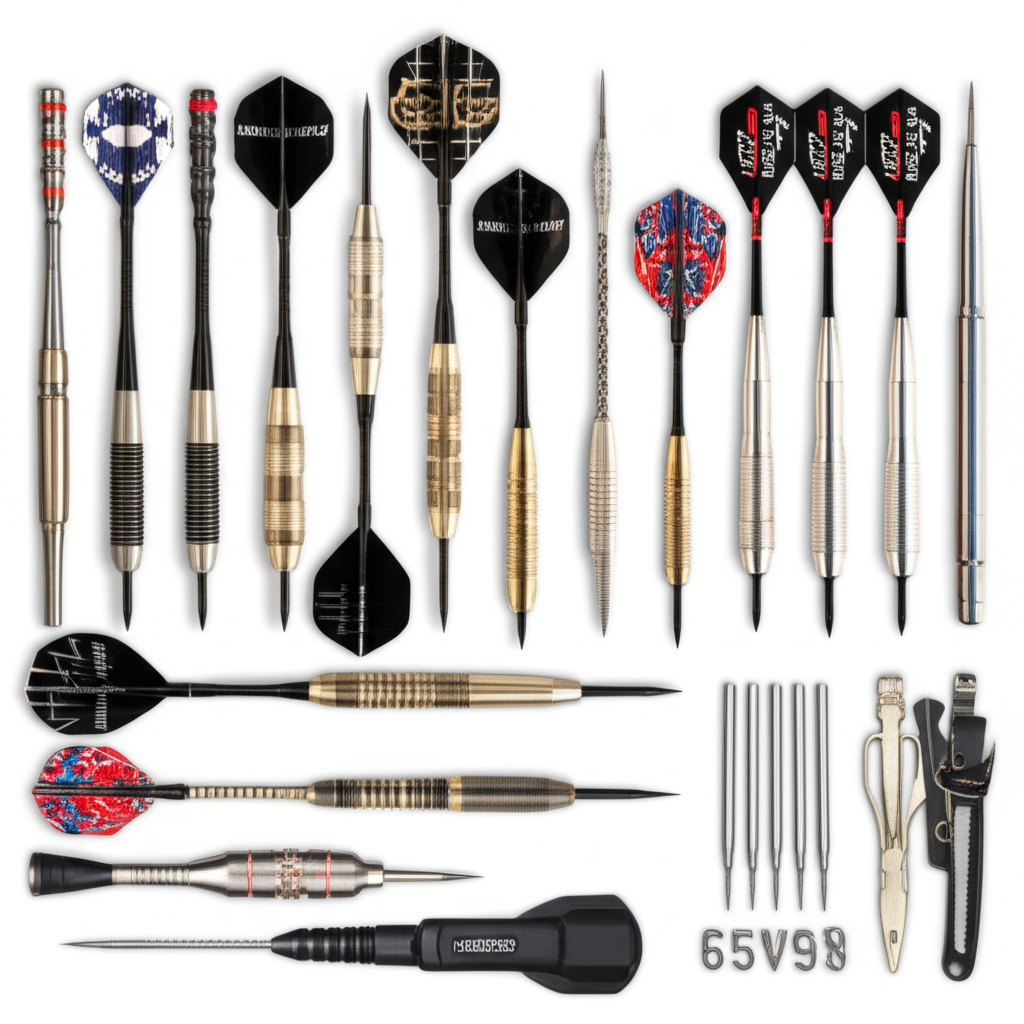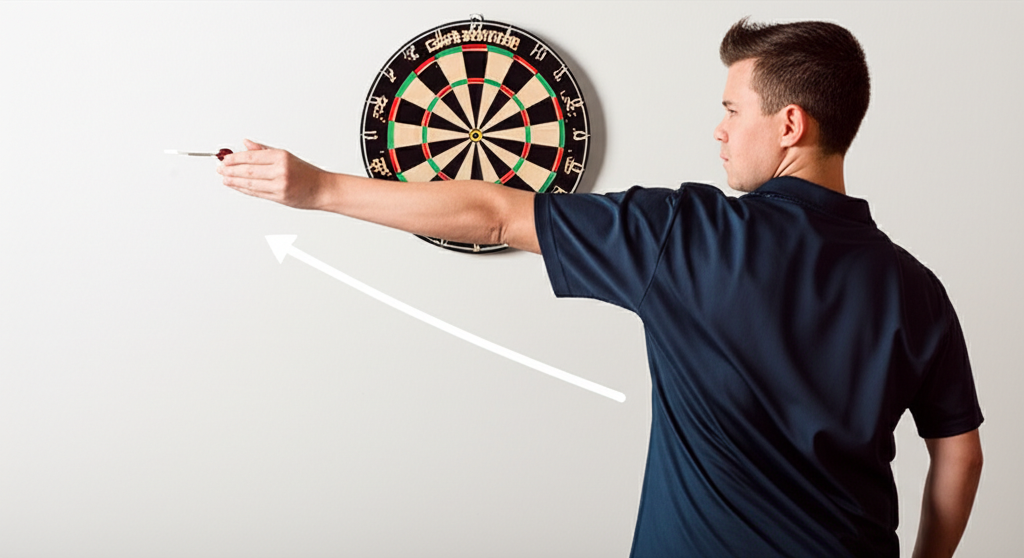For those new to darts, understanding the basic rules and knowing where to begin can feel overwhelming. This comprehensive guide will walk you through everything you need to know to start your darts journey with confidence—from essential equipment and official rules to practice techniques that will help you improve quickly.
Getting Started: Essential Darts Equipment
Before diving into the rules and techniques, it's important to understand the basic equipment you'll need to play darts properly.

The Dartboard
A standard dartboard is divided into 20 numbered segments, arranged non-sequentially to penalize inaccuracy. Each segment contains single, double, and triple scoring areas:
- Singles: The largest areas of each segment, worth the face value (1-20)
- Doubles: The outer narrow ring, worth twice the segment's value
- Triples: The inner narrow ring, worth three times the segment's value
- Bullseye: The center of the board consists of an outer bull (25 points) and inner bull or "bullseye" (50 points)
Professional boards are made of sisal fibers (compressed bristle), which allow darts to penetrate while "self-healing" when the darts are removed.
Darts
Darts come in various weights, shapes, and materials. As a beginner, here's what you should know:
- Weight: Typically between 18-26 grams, with beginners often finding 21-24 gram darts easier to control
- Barrel: The main part of the dart where you grip (brass, nickel, tungsten)
- Shaft/Stem: Connects the barrel to the flight (plastic, aluminum, carbon fiber)
- Flight: The "wing" that stabilizes the dart in flight (various shapes affect trajectory)
- Tip: Steel tips for bristle boards, soft tips for electronic boards
Dartboard Setup Measurements
- Board Height: The bullseye should be 5 feet 8 inches (1.73 meters) from the floor
- Throwing Distance: The oche (throwing line) should be 7 feet 9.25 inches (2.37 meters) from the face of the dartboard
- Diagonal Measurement: From the bullseye to the floor at the oche should be 9 feet 7.375 inches (2.93 meters)
Basic Rules: How to Play Darts
Now that you understand the equipment, let's cover the fundamental rules that apply to most darts games:
Basic Gameplay
- Stance: Stand at or behind the oche (throwing line), with at least one foot on the ground during the throw
- Turns: Players throw three darts per turn (unless the game ends mid-turn)
- Scoring: Only darts that stick in the board count for scores
- Retrieval: Darts are only retrieved after all three have been thrown and scores recorded
- Bounce-outs: If a dart bounces off the board, it cannot be re-thrown
Throwing Technique
While everyone develops their own style, these fundamentals will help you start with proper technique:
The 4-Step Darts Technique
Stance
Position feet shoulder-width apart, with dominant foot slightly forward, body angled toward the board
Grip
Hold dart with 3-4 fingers, firm but relaxed, consistent for each throw
Aim
Focus eyes on target, raise dart to eye level, align with dominant eye
Throw
Use forearm only, smooth motion, minimal wrist action, follow through toward target
Popular Darts Game Types
There are dozens of darts games, but these are the most popular ones you'll encounter as you begin your darts journey:
501/301 (Standard Game)
This is the standard game played in professional competitions and the most popular game worldwide.
- Starting Score: Players begin with 501 (or 301) points
- Objective: Reduce your score to exactly zero
- Finishing: In official play, the final dart must land in a double or the bullseye ("double out")
- Busting: If a player scores more points than needed to reach zero, the entire turn is void ("bust"), and they return to their score before that turn
Example 501 Game
Starting: 501 points
First turn: Triple 20 (60) + Triple 20 (60) + Triple 19 (57) = 177 points
Remaining: 501 - 177 = 324 points
Second turn: Triple 20 (60) + Triple 20 (60) + Triple 20 (60) = 180 points
Remaining: 324 - 180 = 144 points
Third turn: Triple 20 (60) + Triple 16 (48) + Double 18 (36) = 144 points
Perfect finish with double!
Cricket
Cricket focuses on numbers 15 through 20 plus the bullseye, combining strategy with accuracy.
- Objective: "Close" numbers 15-20 and bullseye by hitting each three times, while scoring more points than your opponent
- Closing: After hitting a number three times, it's "closed" (marked with ⨯)
- Scoring: If you hit a number that you've closed but your opponent hasn't, you score the value of that number
- Winning: Close all numbers and have equal or more points than your opponent
Around the Clock (Round the Board)
A simple game ideal for beginners learning board navigation and accuracy.
- Objective: Hit each number in sequence from 1 to 20
- Progression: You can only move to the next number after hitting the current target
- Variations: Some play requiring doubles or triples for added difficulty
Practice Techniques for Beginners
Consistent practice is the key to improving your darts game. Here are some effective practice routines for beginners:
Accuracy Drills
- Around the Clock: Hit numbers 1-20 in sequence, three rounds daily
- 121 Practice: Aim for three darts at the 20 segment, tracking your average score
- Bullseye Practice: Throw 10 sets of three darts at the bullseye, tracking hits
- Doubling Out: Practice hitting specific doubles, crucial for finishing games
Tracking Progress
Keep a practice journal or use a scoring app to track your progress. Note your scores, accuracies, and areas needing improvement. Setting measurable goals will keep you motivated and help identify weaknesses.
Try DartPoint for Tracking Practice
Our app makes it easy to track your darts practice and game statistics. Monitor your improvements, identify patterns, and elevate your game with detailed analytics.
Darts Etiquette and Rules of Conduct
Understanding proper etiquette is important, especially when playing in public venues or joining leagues:
- Respect the Throw: Stand well back from players while they're throwing and remain still
- Scoring: Wait until all three darts are thrown before approaching the board to score and retrieve darts
- Board Access: After your turn, move away quickly to allow the next player access
- Chalk/Scorekeeping: Clearly mark scores and double-check calculations
- Sportsmanship: Acknowledge good throws and avoid excessive celebration or disappointment
Taking Your Game to the Next Level
Once you've mastered the basics, consider these next steps to further develop your skills:
Joining Leagues and Tournaments
Local darts leagues provide regular competition and an opportunity to learn from more experienced players. Most pubs and darts clubs welcome beginners, and leagues often have divisions based on skill level.
Watching Professional Darts
Study professional matches to improve your understanding of strategy and technique. Major tournaments like the PDC World Championship and Premier League Darts offer master classes in high-level play.
Upgrading Equipment
As you improve, consider investing in better equipment. Higher-quality tungsten darts with a weight and balance that suits your throw can make a significant difference to your consistency.
Finding Your Ideal Dart Weight
Your ideal dart weight depends on your throwing style. This chart can help guide your selection:
Lighter Darts (18-21g)
- Faster throwing style
- More wrist action in throw
- Longer distance throwers
Heavier Darts (22-26g)
- More deliberate throwing style
- Less wrist action
- Prefer more stability
Tip: Try different weights at a local darts shop or borrow from other players before investing in your own set.
Common Beginner Mistakes to Avoid
Being aware of these common pitfalls will help accelerate your improvement:
- Inconsistent Stance: Standing differently for each throw leads to inconsistent results
- Grip Shifting: Changing your grip between throws disrupts muscle memory
- Dartboard Fixation: Focusing on the entire board rather than your specific target
- Rushing Throws: Throwing too quickly without proper setup and aim
- Poor Follow-Through: Dropping your arm immediately after release instead of completing the motion
- Overthinking: Analysis paralysis instead of developing natural rhythm
Final Thoughts: Enjoying Your Darts Journey
Darts is a game that offers endless opportunities for improvement, but it's also meant to be enjoyable. Don't get discouraged by slow progress—even professional players constantly work to refine their game.
The beauty of darts lies in its accessibility and social nature. Whether you're playing casually with friends or working toward competitive play, focus on consistent practice, good technique, and having fun.
Remember that every great player started as a beginner. With regular practice and by applying the techniques and rules outlined in this guide, you'll be hitting trebles and closing out games before you know it.
Start your darts journey today—set up your board, grab your darts, and step up to the oche. The only way to improve is to throw, throw, and throw some more. 🎯
